
East Germany, officially known as the German Democratic Republic, was a country in Central Europe from its formation on 7 October 1949 until its reunification with West Germany on 3 October 1990. Until 1989, it was generally viewed as a communist state and described itself as a socialist "workers' and peasants' state". The economy of the country was centrally planned and state-owned. Although the GDR had to pay substantial war reparations to the Soviets, its economy became the most successful in the Eastern Bloc.
The Soviet Military Administration in Germany was the Soviet military government, headquartered in Berlin-Karlshorst, that directly ruled the Soviet occupation zone in Germany from the German surrender in May 1945 until after the establishment of the German Democratic Republic (GDR) in October 1949.
These are lists of political office-holders in East Germany. The political leadership of East Germany was distributed between several offices. However, until the Volkskammer removed a section in the GDR's constitution guaranteeing their monopoly on political power on 1 December 1989, the Socialist Unity Party of Germany (SED) held ultimate power and authority over state and government. Thus, the head of the SED's Politburo of the Central Committee was the de facto leader of the country.

The Bizone or Bizonia was the combination of the American and the British occupation zones on 1 January 1947 during the occupation of Germany after World War II. With the addition of the French occupation zone on 1 August 1948 the entity became the Trizone. Later, on 23 May 1949, the Trizone became the Federal Republic of Germany, commonly known as West Germany.

The Soviet occupation zone in Germany was an area of Germany that was occupied by the Soviet Union as a communist area, established as a result of the Potsdam Agreement on 2 August 1945. On 7 October 1949 the German Democratic Republic (GDR), commonly referred to in English as East Germany, was established in the Soviet occupation zone.
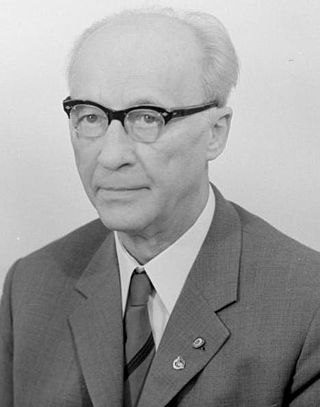
Johannes Dieckmann was a German journalist and politician who served as the 1st President of the Volkskammer, the parliament of East Germany, from 1949 to 1969.
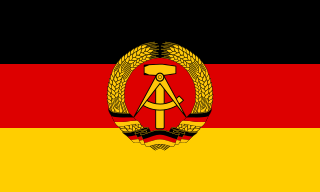
The German Democratic Republic (GDR), German: Deutsche Demokratische Republik (DDR), often known in English as East Germany, existed from 1949 to 1990. It covered the area of the present-day German states of Mecklenburg-Vorpommern, Brandenburg, Berlin, Sachsen, Sachsen-Anhalt, and Thüringen. This area was occupied by the Soviet Union at the end of World War II excluding the former eastern lands annexed by Poland and the Soviet Union, with the remaining German territory to the west occupied by the British, American, and French armies. Following the economic and political unification of the three western occupation zones under a single administration and the establishment of the Federal Republic of Germany in May 1949, the German Democratic Republic was founded on 7 October 1949 as a sovereign nation.
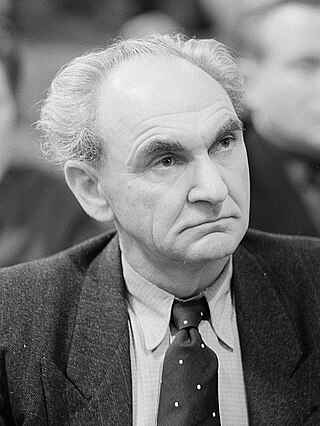
Heinrich Gottlob "Heiner" Rau was a German communist politician during the time of the Weimar Republic; subsequently, during the Spanish Civil War, he was a leading member of the International Brigades and after World War II a leading East German statesman.

The Detlev-Rohwedder-Haus is a building in Berlin that, at the time of its construction, was the largest office building in Europe. It was constructed between February 1935 and August 1936 to house the German Ministry of Aviation, headed by Hermann Göring.
The German People's Council was a consultative body in the Soviet Occupation Zone of Germany that operated in 1948-1949. The main task of the People’s Council was to draw up a constitution on the basis of a draft presented by the SED in 1946.
The German People's Congress were a series of congresses held in Germany. They consisted of members of the Socialist Unity Party, the SED, and other political parties and mass organizations. Delegates from all over Germany gathered for the first time on 6 December 1947. Their main demand was the establishment of a German government.

The Soviet Control Commission was a monitoring and management committee established by the Soviet Union in order to oversee the leadership of the German Democratic Republic. It was active from 10 October 1949 and 20 September 1955 and it was legitimated by the Potsdam Agreement between the Allies.
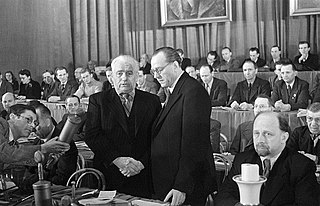
The Communist Party of Germany (KPD) and the east German branches of the Social Democratic Party of Germany (SPD) merged to form the Socialist Unity Party of Germany (SED) on 21 April 1946. Although nominally a merger of equals, the merged party quickly fell under Communist domination and developed along lines similar to other Communist Parties in what became the Eastern Bloc. The SED would be the only party of the German Democratic Republic until the end of the republic in December 1989. In the course of the merger, about 5,000 Social Democrats who opposed it were detained and sent to labour camps and jails.
The Ministry of Justice of the German Democratic Republic was established in 1949 in East Germany and dissolved in 1990. Its duties were subsequently taken up by the federal Ministry of Justice of the united Germany, and the justice ministries of the six new federal states. The Ministry was housed at 93 Dorothea Street, the former offices of the Weimar and Nazi Interior Ministry. It published the journal Neue Justiz.

Deutsche Volkszeitung was a newspaper published daily from Berlin, Germany between 1945–1946. It was the organ of the Central Committee of the Communist Party of Germany (KPD).
Eberhard Heinrich was a German journalist.
Arthur Lieutenant was a German Liberal politician.
Rudolf Steinwand was a German politician. Uncompromising in his political stance, he spent many of the twelve Hitler Years in prisons or concentration camps.
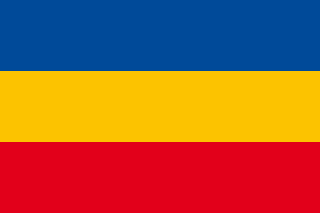
The State of Mecklenburg was a subdivision of the Soviet occupation zone and one of the states of East Germany which corresponds widely to the present-day German state Mecklenburg-Vorpommern. The state was originally formed as an administrative division, the State of Mecklenburg-Vorpommern, by the Soviet Military Administration in Germany (SMAD) in July 1945. It consisted of the 1934-established Mecklenburg and parts of the former Prussian provinces of Pommern and Hanover. The city of Swinemünde was handed over to Poland in October 1945, becoming part of Szczecin Voivodeship. In November 1945, a transfer of small territories along the Inner German border to the former Province of Schleswig-Holstein was carried out as part of the Barber–Lyashchenko Agreement. About 2.1 million people were estimated to live in Mecklenburg in 1946. From 1947, the term Vorpommern was excluded from the official name as the SMAD feared that this would support revisionist actions against formerly German parts of Poland. Compared to the administrative divisions of Nazi Germany, Mecklenburg comprised the Gaue Mecklenburg and parts of Pomerania and Eastern Hanover.

Katharina "Käthe" Kern became a German anti-government activist during the Hitler years. After 1945 she quickly emerged as a senior politician and party loyalist in the Soviet occupation zone. She served between 1946 and 1985 as a member of what became the powerful Party Central Committee. A long-standing leading figure in the Ministry for the Health Service), she also served, between 1949 and 1970, as head of the national "Mother and Child department".












